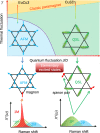Dynamic fingerprint of fractionalized excitations in single-crystalline Cu3Zn(OH)6FBr
- PMID: 34031422
- PMCID: PMC8144382
- DOI: 10.1038/s41467-021-23381-9
Dynamic fingerprint of fractionalized excitations in single-crystalline Cu3Zn(OH)6FBr
Abstract
Beyond the absence of long-range magnetic orders, the most prominent feature of the elusive quantum spin liquid (QSL) state is the existence of fractionalized spin excitations, i.e., spinons. When the system orders, the spin-wave excitation appears as the bound state of the spinon-antispinon pair. Although scarcely reported, a direct comparison between similar compounds illustrates the evolution from spinon to magnon. Here, we perform the Raman scattering on single crystals of two quantum kagome antiferromagnets, of which one is the kagome QSL candidate Cu3Zn(OH)6FBr, and another is an antiferromagnetically ordered compound EuCu3(OH)6Cl3. In Cu3Zn(OH)6FBr, we identify a unique one spinon-antispinon pair component in the E2g magnetic Raman continuum, providing strong evidence for deconfined spinon excitations. In contrast, a sharp magnon peak emerges from the one-pair spinon continuum in the Eg magnetic Raman response once EuCu3(OH)6Cl3 undergoes the antiferromagnetic order transition. From the comparative Raman studies, we can regard the magnon mode as the spinon-antispinon bound state, and the spinon confinement drives the magnetic ordering.
Conflict of interest statement
The authors declare no competing interests.
Figures






Similar articles
-
Bosonic spinons in anisotropic triangular antiferromagnets.Nat Commun. 2021 Nov 9;12(1):6453. doi: 10.1038/s41467-021-26716-8. Nat Commun. 2021. PMID: 34753923 Free PMC article.
-
Fractionalized excitations in the partially magnetized spin liquid candidate YbMgGaO4.Nat Commun. 2018 Oct 8;9(1):4138. doi: 10.1038/s41467-018-06588-1. Nat Commun. 2018. PMID: 30297766 Free PMC article.
-
Gapless dispersive continuum in a modulated quantum kagome antiferromagnet.Nat Commun. 2025 Apr 26;16(1):3939. doi: 10.1038/s41467-025-58971-4. Nat Commun. 2025. PMID: 40287419 Free PMC article.
-
Potential of Raman scattering in probing magnetic excitations and their coupling to lattice dynamics.J Phys Condens Matter. 2024 Sep 16;36(49). doi: 10.1088/1361-648X/ad75db. J Phys Condens Matter. 2024. PMID: 39214140 Review.
-
On the proximate Kitaev quantum-spin liquid α-RuCl3: thermodynamics, excitations and continua.J Phys Condens Matter. 2021 Aug 27;33(44). doi: 10.1088/1361-648X/ac1bcf. J Phys Condens Matter. 2021. PMID: 34371492 Review.
References
Grants and funding
- 2019TQ0317/China Postdoctoral Science Foundation
- 2020M682780/China Postdoctoral Science Foundation
- 12004377/National Natural Science Foundation of China (National Science Foundation of China)
- 11774143/National Natural Science Foundation of China (National Science Foundation of China)
- 11874350/National Natural Science Foundation of China (National Science Foundation of China)
LinkOut - more resources
Full Text Sources
Other Literature Sources

